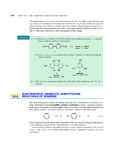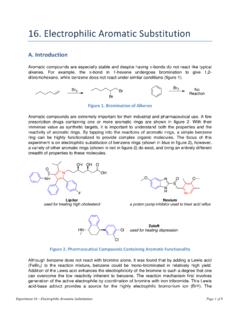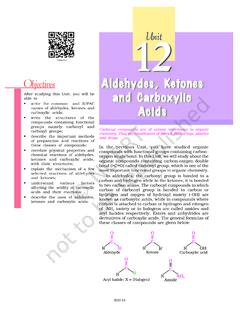Transcription of Reaction Mechanisms - IITPK
1 158 Essential Notes on General Organic Chemistry ( ) The IITian s Prashikshan Kendra Pvt. Ltd. Topics Coverage :- substitution reactions Free Radical reactions SN1 Mechanism SN2 Mechanism SN1 v/s SN2 Mechanisms E1 Mechanism E2 Mechanism E1 v/s E2 Mechanisms substitution v/s Elimination reactions aromatic substitution electrophilic Mechanism aromatic substitution Nucleophilic Mechanism Addition Nucleophilic Mechanism Addition electrophilic Mechanism Addition Free Radical Mechanism RARE Mechanisms : (SNi, E1cb, SN', NGP, Benzyne, Ipso) Rearrangements Introduction : How exactly does an organic Reaction take place is the subject of study in this chapter of Reaction Mechanisms . Just as detectives investigate a crime after it has taken place and arrive at a reasonable prediction about how the crime may have occurred, similarly organic chemists predict by a number of laboratory techniques using sophisticated instrumentation how an organic Reaction may have taken place.
2 Many of these techniques are based on the Physical Chemistry principles of Redox, Equilibria, Chemical Kinetics and Thermodynamics. The instruments used include Polarimeter, NMR Spectroscope, Electric Dipole measurement device, isotopic tracer, pH meter etc. CLASSIFICATION OF ORGANIC reactions Organic reactions in JEE syllabi can be classified as under : 1. substitution reactions - (i) Free radical (ii) Nucleophilic-SN1, SN2,SNi (iii) electrophilic 2. Elimination reactions -E1, E2 & E1cb 3. Addition reactions - (i) electrophilic (ii) Nucleophilic (iii) Free Radical 4. Rearrangements 4 CHAPTER Reaction Mechanisms Essential Notes on General Organic Chemistry ( ) 159 Reaction Mechanisms .
3 1. substitution reactions A Reaction in which one group or atom is replaced by another is called a substitution Reaction . The incoming group is bonded to the same carbon to which the leaving group was bonded. substitution Reaction has been classified according to the nature of the substituents involved. Thus- A. Free radical substitution + +BQAQBA:: B. Nucleophilic substitution + +BQAQBA:::: C. electrophilic substitution + +BQAQBA:: It will be seen that in all types of substitutions, the displaced species belong to the same class as the attacking species. A. Free Radical substitution Radical substitution reactions are initiated by radicals in the gas phase or in non-polar solvents. Thus, methane and chlorine react in the presence of sunlight or heat to give methyl chloride.
4 HClClCHClCHCorhv++ + 330024 Light energy or heat causes homolytic fission of chlorine producing chlorine radicals which attack methane to form methyl chloride. + ClClClClCorhv300: ..(i) HClCHClHCH+ + 33:..(ii) + + (iii) B. Nucleophilic substitution (Common in aliphatic compounds): Nucleophilic substitution is one of the two main reactions of alkyl halides. A nucleophile replaces a leaving group on an sp3 hybridized carbon. One bond is broken and one bond is formed. There are two possible Mechanisms : SN1 and SN2 The electron pair in the C Nu bond comes from the nucleophile. R X + Nu R Nu + :X nucleophile leaving group 160 Essential Notes on General Organic Chemistry ( ) The IITian s Prashikshan Kendra Pvt.
5 Ltd. SN1 and SN2 Mechanisms Compared SN2 Mechanism SN1 Mechanism [1] Mechanism One step Two steps [2] Alkyl halide Order of reactivity : CXRCHXRXRCHXCH2223>>> Order of reactivity : XCHXRCHCHXRCXR3223>>> [3] Rate equation Rate = ]][:[NuRXk Second order kinetics Rate = ][RXk First order kinetics [4] Stereochemistry Backside attack of the nucleophile Inversion of configuration at a stereogenic center Trigonal planar carbocation intermediate Racemization at a single stereogenic center [5] Nucleophile Favored by stronger nucleophiles Favored by weaker nucleophiles [6] Leaving group Better leaving group faster Reaction Better leaving group faster Reaction [7] Solvent Favored by polar aprotic solvents Favored by polar protic solvents [8] Reactivity structure of R-determining factor.
6 Nature of X 3 > 2 > 1 > CH3 Stability of R+ RI > RBr > RCl > RF CH3 > 1 > 2 > 3 Steric hindrance in R group RI > RBr > RCl > RF [9] Effect of nucleophile Rate depends on nucleophilicity I > Br > Cl ; RS > RO No effect on rate [10] Catalysis Lewis acid, Ag+,AlC3, ZnCl2 None of these [11]Competition reactions Elimination, rearrangement Elimination [12] TS of slow step Factors to decide whether SN1 or SN2 : Any factors that affects the energy of activation of a given type of Reaction will affect the rate and / or mechanism. These factors are useful to decide whether SN1 or SN2 occurs : 1. Electronic effect 2. Steric effect 3. The nature of the leaving group. 4. The nature of the nucleophile. 5. Participation of neighbouring group.
7 6. Effect of solvent. 1. ELECTRONIC EFFECT :- I-effect, R-effect, hyperconjugation etc. which can affect the stability of carbocation are collectively termed as electronic effect. Clearly if electronic effects stabilise the carbocation, 1 NSwill more probable than 2NS. XCNu X C + )1( XC )2( XC )3( XC 2NS 2 NSor 1NS 1NS Essential Notes on General Organic Chemistry ( ) 161 Reaction Mechanisms . 2. STERIC EFFECT :- More steric restriction opposes 2 NSmechanism. Simple alkyl halides show the following general order of reactivity in 2 NSreactions: methyl > primary > secondary >>(tertiary) Methyl halides react most react most rapidly and tertiary halides react so slowly as to be unreactive by the SN2 mechanism.
8 3. THE NATURE OF LEAVING GROUP :- The ease of formation of carbocation supports SN1 and this formation depend upon nature of leaving group. The best leaving group is the weakest base. Leaving group ability increases left-to-right across a row and down a column of the periodic table. The ease of leaving is as follows : The leaving power of some nucleophilic groups is given below in decreasing order : 4. THE NATURE OF THE NUCLEOPHILE :- Stronger nucleophile supports 2NS mechanism. Strength of nucleophile is as follows : :3 NMeClPhOBrOHOEtICNPhS>>>>> >>> 5. Participation of Neighbouring Groups : Some neighbouring groups as : , COO PhCOOHXO||,,etc. can also participate and determine the nucleophilic substitution .
9 6. Effect of solvent : As the dielectric constant ( , polarity) of solvent increases, the rate of 1 NSreaction increases. Illustration : Indicate the effect on the rate of SNl and SN2 reactions of the following: (a) Doubling the concentration of substrate (RL) or Nu. (b) Using a mixture of ethanol and H2O or only acetone as solvent. (c) Increasing the number of R groups on the C bonded to the leaving group, L. (d) Using a strong Nu. Ans: (a) Doubling either [RL] or [ Nu] doubles the rate of the SN2 Reaction . For SN1 reactions , the rate is doubled only by doubling [RL] and is not affected by any change in [ Nu]. CF3 S O O O > Br S O O O > CH3 S O O O > C6H5 S O O O > CH3 S O O O > I > Br > CF3 C O O > H2O > Cl > F CH3 C O > O 162 Essential Notes on General Organic Chemistry ( ) The IITian s Prashikshan Kendra Pvt.
10 Ltd. (b) A mixture of ethanol and H2O has a high dielectric constant and therefore enhances the rate of SN1 reactions . This usually has little effect on SN2 reactions . Acetone has a low dielectric constant and is aprotic and favors SN2 reactions . (c) Increasing the number of R s on the Reaction site enhances SN1 reactivity through electron release and stabilization of R+. The effect is opposite in SN2 reactions because bulky R s sterically hinder formation of, and raise ++ Hfor, the transition state. (d) Strong nucleophiles favor SN2 reactions and do not affect SN1 reactions Illustration : List the following alkyl bromides in order of decreasing reactivity in indicated reactions . (a) SN1 reactivity, (b) SN2 reactivity, (c) reactivity with alcoholic AgNO3.




